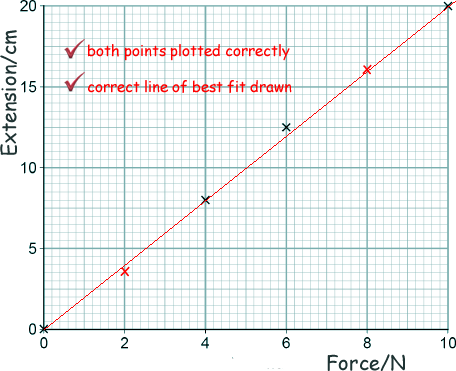GCSE Questions: Hooke's Law Q1. Katrina carried out an investigation to determine the spring constant of a spring. Here is her results table:
Describe a method she could have used to obtain this data. Your answer should include any cause of inaccuracy in the data. Your answer may include a labelled diagram.
- the examiner looks for relevant instructions - but also for the correct order - and any opposing instructions make you lose marks! It is not just a 'tick fest' - but a marker does look to see how many relevant points you have made, then considers how you have strung them together to put your answer into a 'level'
Indicative content they looked for:
[6 marks] (b) Katrina measured the extension for five different forces rather than just measuring the extension for one force. Suggest why. It was 'to identify any anomalous results' or 'to reduce the effect of random error'.
[1 mark] (c) This graph has some of the data obtained by Katrina already plotted.
Complete the graph by plotting the missing data and draw in the line of best fit.
[2 marks] (d) Write down the equation that links extension, force and spring constant. Force = spring constant x extension F = ke [1 mark] (e) Calculate the spring constant of the spring that Katrina used. Give your answer in newtons per metre.
k = F/e k = 10 N/20 cm
k = 10 N/ 0.20 m [4 marks] (f) Hooke's Law states that:
Katrina concluded that over the range of force used, the spring obeyed Hooke's Law. Explain how the data supports her conclusion. The line is straight [2 marks] [16 Marks TOTAL] |
Follow me...
|






